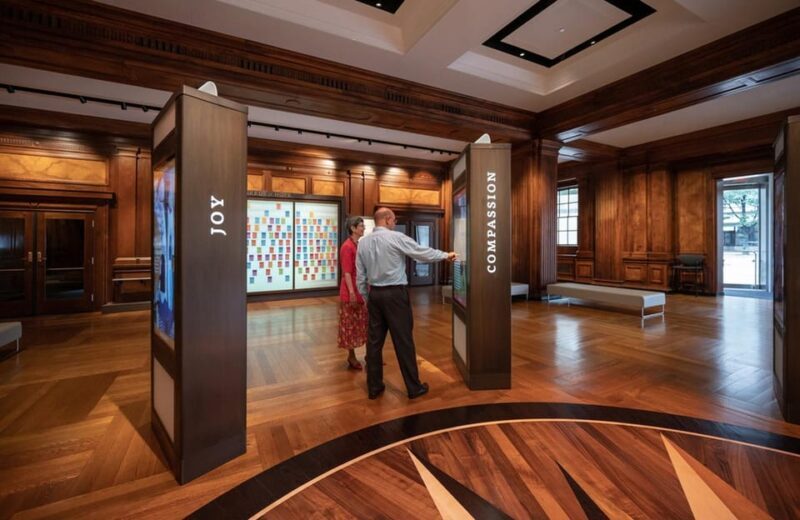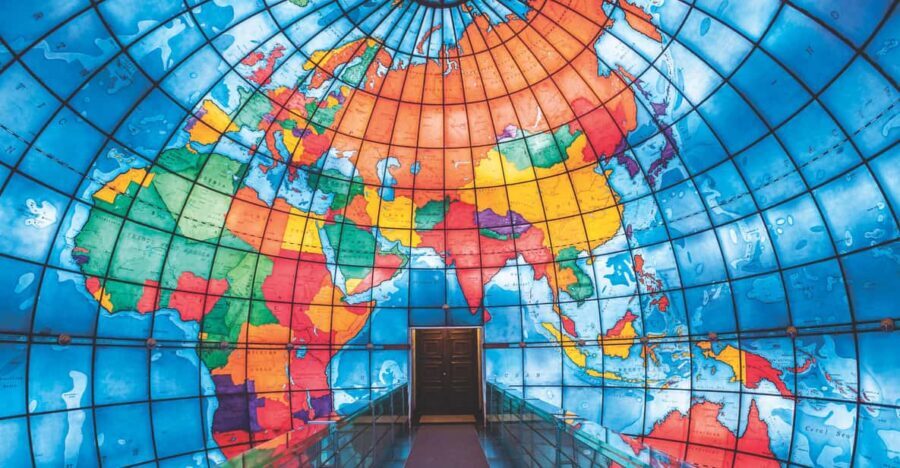Exploring Boston’s Christian Science Plaza means more than just snapping photos of historic sites. For a modest $6, you can step inside the world-famous Mapparium® globe, a colorful stained-glass marvel that’s three stories tall, and then wander through inspiring exhibits about global progress and human achievement. This experience takes roughly 20 minutes, making it a perfect quick cultural stop that’s both educational and visually stunning.
What really stands out for us are two key elements: the spectacular interior of the Mapparium, where the stained glass creates a kaleidoscope of colors, and the engaging multimedia exhibits that celebrate human progress since 1935. These exhibits feel thoughtfully curated, offering hope and inspiring stories amidst a modern setting. The only potential downside? The timed entry to the Mapparium means you’ll want to plan ahead to avoid missing out during busy times — but that’s a small price for such an intimate view of a world frozen in time.
This tour suits travelers who appreciate architecture, history, and international stories. It’s especially appealing for those who want a meaningful experience without spending hours. Whether you’re visiting Boston for a day or looking to add a thoughtful pause to your trip, this experience offers both visual delight and educational value.
Key Points

- Stunning Visuals: The three-story stained glass Mapparium is a highlight, especially for architecture and stained-glass lovers.
- Insightful Exhibits: Discover humanity’s progress since 1935 with engaging multimedia presentations.
- Historical Perspective: Walk through the globe as it was in 1935, offering a glimpse of the world before World War II.
- Educational Content: Learn about Mary Baker Eddy and her influence through dedicated exhibits.
- Affordable and Accessible: All exhibits are free, with only the Mapparium requiring a ticket, making it great value.
- Time-Efficient: The entire experience lasts about 20 minutes, perfect for a quick cultural stop.
When we arrived at the Christian Science Plaza, we looked for the large banners reading “How Do You See the World?”—a clear sign of the entrance. For just $6 per person, we bought timed tickets for the Mapparium, which guarantees you a slot to walk through this iconic globe. The 20-minute experience is concise but packed with visual and audio stimuli, making it ideal for travelers on a tight schedule.
Walking into the Mapparium feels like stepping into a giant stained-glass kaleidoscope. The globe, suspended in a three-story structure, is a spectacle of vibrant colors and intricate details. As you move through it, a narrator inside provides a fascinating commentary that feels personal and engaging. It’s a rare chance to see a globe from the inside, where the details of continents and borders are sharply outlined in stained glass, all frozen in 1935. The experience offers a unique perspective, especially since the borders reflect the world as it was before the upheaval of WWII.
Beyond the globe, the “Our World: Mapping Progress” exhibit captures the journey of humankind since 1935. It celebrates advances in science, human rights, exploration, and more, giving us hope about what the future might hold. The exhibits are multimedia-rich, combining photos, videos, and interactive stories from The Christian Science Monitor, founded by Mary Baker Eddy. This newspaper’s mission to “injure no man, but to bless all mankind” resonates throughout the exhibits, illustrating stories of resilience, innovation, and global connection.
The “Points of Progress” section highlights pivotal moments, like scientific breakthroughs or human rights milestones, using dynamic displays that keep visitors engaged. As one reviewer noted, the exhibits are vibrant and immersive, successfully transporting visitors through decades of global change.
Learning about Mary Baker Eddy, the founder of Christian Science, adds another layer of depth. Her exhibits explore her lifelong love of the Bible and her spiritual teachings, connecting her personal journey to the broader themes of hope and universal understanding. For those curious about religious influence on social progress, this part of the tour is both informative and inspiring.
The visual impact of the Mapparium alone is worth the visit. Its stained glass, depicting the world as it was in 1935, offers an almost surreal, kaleidoscopic view of the continents. It’s a great photo opportunity, but more importantly, it’s a chance to see how the world was perceived before the turbulence of the mid-20th century.
The “How Do You See the World?” experience is a modern multimedia presentation that frames the globe within a narrative about perspective and understanding. It encourages visitors to reflect on their worldview, making the visit personal and meaningful—something many travelers find refreshing amid the more conventional historic sites.
One element our readers will appreciate is the free access to exhibits beyond the Mapparium, which include the Christian Science and Mary Baker Eddy exhibits. These offer deeper insights into her life and legacy, providing context that enriches the entire experience.
You can check availability for your dates here:Practical Tips for Visitors

Since the Mapparium requires a timed ticket, it’s best to reserve in advance through GetYourGuide — especially during peak times. The exhibits outside the globe are always free, so you can explore at your leisure if you prefer to skip the timed entry, but keep in mind that the globe itself is the main highlight.
The entire experience is wheelchair accessible and suitable for most visitors. Be prepared for a quiet environment inside the globe; a gentle reminder to keep conversations low ensures everyone can enjoy the narrated presentation.
Note that food and drinks are not allowed inside the exhibits, so plan accordingly. The experience is quick, so it pairs well with other nearby attractions or a walk along Boston’s scenic public spaces.
For just $6, this experience offers a rich, visually stunning view of the world as it was in 1935, combined with thought-provoking exhibits on progress and human achievement. The guided narration inside the globe makes it memorable, and the surrounding multimedia exhibits add depth to your understanding of global change.
If you’re someone who appreciates architecture, history, and inspiring stories, you’ll find this tour both enlightening and entertaining. It’s especially perfect for travelers who want an educational but compact activity that’s easy to fit into a busy schedule. The glowing reviews about knowledgeable guides and beautiful visuals speak to its quality and appeal.
While it’s a brief visit, the impact of seeing the globe from inside and engaging with stories of progress will stay with you. It’s a meaningful stop that combines art, history, and hope—a small but powerful reminder of what humanity has achieved and the future we can shape.
How long does the tour last?
The Mapparium experience takes about 20 minutes, including walking through the globe and listening to the narration. The surrounding exhibits are free and can be explored at your own pace.
Do I need to buy tickets in advance?
Yes, the Mapparium requires a timed entry ticket. It’s best to reserve through GetYourGuide to secure your preferred time slot, especially during busy periods.
Are all exhibits free?
All exhibits outside the Mapparium, including the “How Do You See the World?” experience and the Mary Baker Eddy exhibits, are always free. Only the Mapparium itself requires a ticket.
Is the experience accessible for wheelchair users?
Yes, the entire experience is wheelchair accessible, making it inclusive for most visitors.
Can I visit without a timed ticket?
While the exhibits are free, the Mapparium requires a timed ticket. You can visit the other exhibits without a reservation.
Are food and drinks allowed inside?
No, food and drinks are not permitted within the exhibits to maintain a quiet, respectful environment.
What’s the best time to visit?
Morning or early afternoon slots tend to be less crowded, but check availability and book in advance to avoid disappointment.
This experience is a delightful blend of visual artistry, historical reflection, and hopeful storytelling. It’s a commendable choice for those seeking a meaningful and visually captivating activity in Boston, especially if you enjoy learning about history and exploring perspectives—literally and figuratively.
Planning more time in Boston? We've covered other experiences worth considering.
You can check availability for your dates here:More Tour Reviews in Boston
More Boston experiences we've covered
- Boston: Freedom Trail History Small Group Walking Tour
- Boston: Helicopter Skyline Tour
- Boston: TD Garden Arena Tour
- Boston: Boch Center Wang Theater Behind the Scenes Tour
- Boston: Old State House/Old South Meeting House Museum Combo
- Boston: Ghosts & Gravestones Nightwalk Tour
- Boston: Local Gems of the South End Neighborhood Food Tour
- Boston: Kennebunkport Day Trip with Optional Lobster Tour
- Boston’s North End Immigration History: Walking Tour
- Boston: True Crime, Urban Legends, and Ghostly Tales Tour
- Boston: Boston Red Sox Baseball Game Ticket at Fenway Park
- Boston Jewish History Landmarks Private Guided Walking Tour
